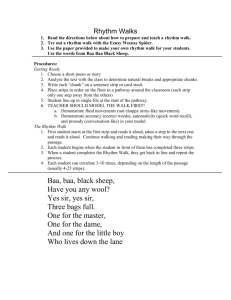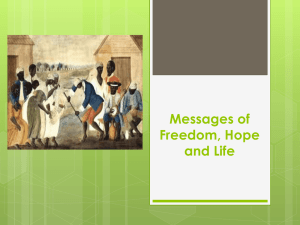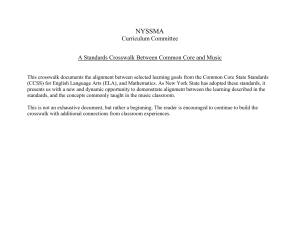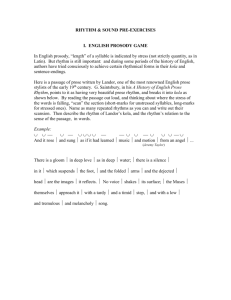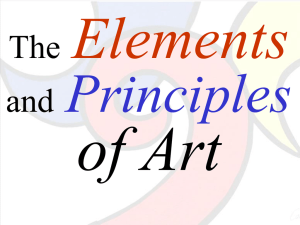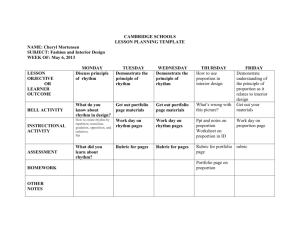Proficient
advertisement
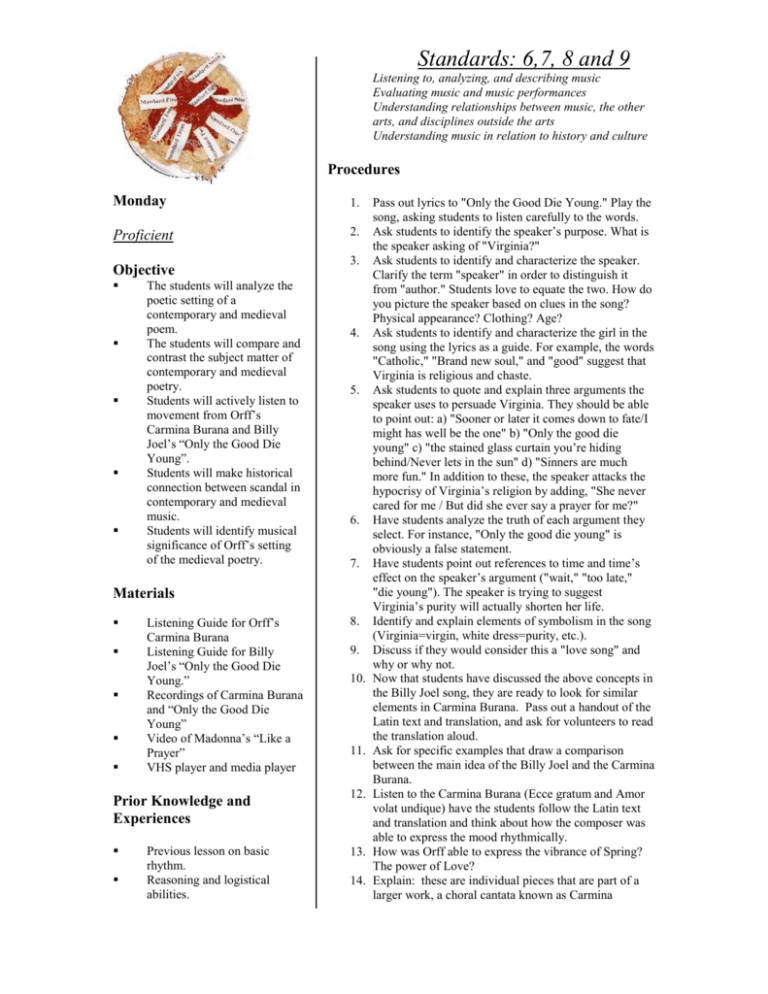
Standards: 6,7, 8 and 9 Listening to, analyzing, and describing music Evaluating music and music performances Understanding relationships between music, the other arts, and disciplines outside the arts Understanding music in relation to history and culture Procedures Monday 1. Proficient 2. Objective The students will analyze the poetic setting of a contemporary and medieval poem. The students will compare and contrast the subject matter of contemporary and medieval poetry. Students will actively listen to movement from Orff’s Carmina Burana and Billy Joel’s “Only the Good Die Young”. Students will make historical connection between scandal in contemporary and medieval music. Students will identify musical significance of Orff’s setting of the medieval poetry. 3. 4. 5. 6. 7. Materials Listening Guide for Orff’s Carmina Burana Listening Guide for Billy Joel’s “Only the Good Die Young.” Recordings of Carmina Burana and “Only the Good Die Young” Video of Madonna’s “Like a Prayer” VHS player and media player 8. 9. 10. 11. Prior Knowledge and Experiences 12. 13. Previous lesson on basic rhythm. Reasoning and logistical abilities. 14. Pass out lyrics to "Only the Good Die Young." Play the song, asking students to listen carefully to the words. Ask students to identify the speaker’s purpose. What is the speaker asking of "Virginia?" Ask students to identify and characterize the speaker. Clarify the term "speaker" in order to distinguish it from "author." Students love to equate the two. How do you picture the speaker based on clues in the song? Physical appearance? Clothing? Age? Ask students to identify and characterize the girl in the song using the lyrics as a guide. For example, the words "Catholic," "Brand new soul," and "good" suggest that Virginia is religious and chaste. Ask students to quote and explain three arguments the speaker uses to persuade Virginia. They should be able to point out: a) "Sooner or later it comes down to fate/I might has well be the one" b) "Only the good die young" c) "the stained glass curtain you’re hiding behind/Never lets in the sun" d) "Sinners are much more fun." In addition to these, the speaker attacks the hypocrisy of Virginia’s religion by adding, "She never cared for me / But did she ever say a prayer for me?" Have students analyze the truth of each argument they select. For instance, "Only the good die young" is obviously a false statement. Have students point out references to time and time’s effect on the speaker’s argument ("wait," "too late," "die young"). The speaker is trying to suggest Virginia’s purity will actually shorten her life. Identify and explain elements of symbolism in the song (Virginia=virgin, white dress=purity, etc.). Discuss if they would consider this a "love song" and why or why not. Now that students have discussed the above concepts in the Billy Joel song, they are ready to look for similar elements in Carmina Burana. Pass out a handout of the Latin text and translation, and ask for volunteers to read the translation aloud. Ask for specific examples that draw a comparison between the main idea of the Billy Joel and the Carmina Burana. Listen to the Carmina Burana (Ecce gratum and Amor volat undique) have the students follow the Latin text and translation and think about how the composer was able to express the mood rhythmically. How was Orff able to express the vibrance of Spring? The power of Love? Explain: these are individual pieces that are part of a larger work, a choral cantata known as Carmina 15. 16. 17. 18. 19. 20. 21. 22. 23. Burana. It was written by Carl Orff in the Twentieth Century over six hundred years after the poetry was written. You see it is this idea of expression that connects us with humanity centuries past, present, and future. It may be hard to believe but people six hundred years ago were experiencing the same primal, complex, and driving emotions that we experience today. Explain: The collection of poems was found as an anthology in a Benedictine Monastery. Can you imagine the scandal when they found the provocative lyrics with pagan origin in such sacred confines. The fact is that the Benedictine monks understood the importance of writing for posterity, much of the literature and historical information from that period would be a mystery if it wasn’t for their efforts of preservation, so they didn’t actually write the poetry, they just saved it, recognizing it as a stylistic representation of the poetry of the Goliards—a nickname which meant “big mouths” and for good reason. These people were scholars, monks and priests who, each for his own reasons, had abandoned conformity to their holy calling; they lived a vagrant life, begging, thieving and singing. They wrote, not about courtly love, but about the carnal pleasures, the joys of spring, gambling and eating, and they took the realistic view that opportunities for their enjoyment were in the hands of the implacable goddess Fortune. Pretty scandalous stuff for a bunch of monks in medieval times. Even for Carl Orff in the 1930’s. Listen to Amor volat undique again. This time have them listen for what musical qualities make the coupling of music and lyric scandalous. Does it sound slinky, lascivious? How did Orff achieve that sound? Striking, yet simple rhythm, tonally, everything is easily accessible, change of meter and mood between chorus and orchestra. Discuss scandal in music. Who are some of the popular icons that express ideas and feelings about some things that our society feels are taboo? Madonna has built an entire career on scandal. Reaching just beneath societies comfort zone and digging in. Like a Virgin and Like a Prayer both lash out against the restrictive nature of the Catholic Church on issues of love. Like a Prayer was particularly scandalous especially after the music video was released. Watch the music video. Why was this scandalous? It was drawing a comparison between religious ecstasy and sexual ecstasy while simultaneously dealing with interracial relationships, and that made organized religion and parents all over the United States a little uneasy. Indicators of Success Students participate and contribute in discussion and analysis of lyrical poetry Students actively listen to music. Students achieve an understanding of historical connection between medieval and contemporary poetry. Students identify importance of music in portraying poetic message. Students achieve an understanding of historical connection between scandalous issues in medieval and contemporary music. Follow-up Further listening of Carmina Burana. Discussion of Fate theme. Lab on the use of scandal, poetry, and rhythm in music. Standards: 5,6,7, 8 and 9 Reading and Notating Music Listening to, analyzing, and describing music Evaluating music and music performances Understanding relationships between music, the other arts, and disciplines outside the arts Understanding music in relation to history and culture Tuesday Proficient Procedures 1. Objective Students will achieve an understanding about the philosophical issue—fate vs. freewill, and how it is employed in contemporary and popular music. Students will review concepts learned the previous day. Students will actively listen to movement from Orff’s Carmina Burana and the Byrd’s “Turn, Turn, Turn”. Students will learn through game play the basics to reading rhythm. 2. 3. 4. What is the main idea? Where is it stated? (Possible responses may include the following: In life, all occurrences are possible. There is balance in life. Both the "good" and "bad" occur in life. There is reassurance in knowing that nothing will stay the same. Everything has its time and place in life. The main idea is found in line 1 of Ecclesiastes 3:1-8 and in stanza 1 in Turn! Turn! Turn!) How does the main point of Pete Seeger’s lyrics compare to that of your own responses? Materials Listening Guide for Carl Orff’s Carmina Burana—O Fortuna. Listening Guide for the Byrd’s “Turn, Turn, Turn”. Recordings of Carmina Burana and “Turn, Turn, Turn”. Media Device Large wheel with interchangeable parts for various levels of play. Prior Knowledge and Experiences High school English level Reasoning skills Previous lesson. Basics of rhythm. As an introductory activity, have the students freewrite on the topic of "change." How do they feel about change?" How does "change" affect them? Where do "they create "change" in their own lives? How do they react to "change" when they have no control over it? Is "change" the same as "progress?" After students have written for 5-10 minutes, go around the room and have each student read all or part of what they have written. Refrain from judgmental comments or discussion at this time. Everyone in the room should just be listening to the variety of ideas expressed. Listen to the song "Turn! Turn! Turn!" Provide copies of the lyrics, and on background of the song as needed.- A reaction to the Vietnam War. Discuss the theme of "Turn! Turn! Turn!" Discussion should include the following points: 5. Introduce the concept of fate. In the pagan sense, our lives are at the hands of a goddess. In the agnostic sense, we are tossed at random through life. This has been a highly debated liturgical and philosophical issue since the start of organized religion. 6. Listen to Carmina Burana—O Fortuna—with lyrical guide, and think about how the composer, Carl Orff accomplishes the sense of a powerful turning wheel through his music. 7. Discuss the wheel of fate. 8. Outreach: What popular music deals with the helplessness of our existence in a way to which we can all relate? 9. Divide the room into 6 groups; designate one member of each group as the team captain—they are responsible for spinning. 10. Round 1—Teams take turns spinning the Wheel of Fortune which is broken into categories based on questions taught between Monday and today and also the previous lesson which pertained to Rhythm. If they correctly and collaboratively answer the question they win a spin—may earn up to 6 spins. 11. Round 2—The group with the most spins will go first. The wheel is refreshed with a new playing surface. Each pie is covered with different rhythmic values—4 quarter notes, 2 whole notes, 2 eighth notes, etc… The teams are playing for beats. Whichever team accomplishes the most beats receives a small bonus on their next test grade. Before the team can earn the beats displayed on each pie, they must first demonstrate an understanding of the rhythmic value of the beats—by correctly clapping the rhythmic figure. 12. If they land on a rest, half of their beats are erased, and they must start again. They can pass on spins to the next group if they feel like their luck is running thin and they are in a good strategic position. All the spins must eventually be used up. 13. Round 3—Each group automatically starts with three spins. The rhythms are divided into measures and are slightly more advanced—also worth more points. Now if they land on a rest, all of their beats are erased— except points from the last round. 14. Round 4—Group with most points gets a bonus and gets to spin first on the new board which gives group assignments for Friday’s class—they will use the same groups… 1. Discuss the expression of fate vs. freewill in popular music, citing specific examples of artists and lyrics. 2. How did Carl Orff feel music should be taught and why did he feel that way? Do you think it would be effective—why? 3. What is the function of rhythm in popular music and music written before the Twentieth Century? Is it the same or different? What influence does culture have on this? 4. Was the music of Beethoven, Mozart, and Liszt ever considered scandalous? Give specific examples. 5. Find four examples of popular artists who address scandalous issues without using vulgar language in their lyrics. Explain the cultural appeal of the lyrics, if they have universal and lasting appeal, using specific references to lyrical statements. 6. Explain the basic system used for notating musical rhythms. Indicators of Success Students achieve an understanding about the philosophical issue—fate vs. freewill, and how it is employed in contemporary and popular music. Students review concepts learned the previous day. Students actively listen to movement from Orff’s Carmina Burana and the Byrd’s “Turn, Turn, Turn”. Students learn, through game play, the basics to reading rhythm. Follow-up Lab on more complex use of rhythm and notation. Lab on syncopation. More examples of how rhythm is a vital part of popular genres. Examples provided of the interesting use of rhythm by contemporary composers and how this correlates to popular music. Standards: 5,6,7, and 9 Reading and notating music Listening to, analyzing, and describing music Evaluating music and music performances Understanding music in relation to history and culture Procedures 1. Wednesday Proficient Put the following terms and definitions on the board: Meter: how many beats per measure (the excerpt of "Dance of the Adolescents" has 2 beats per measure, Sumpin’ New 1,2,3,4 has 4 beats per measure) Objective Students will understand specific musical terms. Students will read and perform basic and complex rhythms. Students will correlate syncopation in popular music to cultural movement of the early Twentieth Century. Students will gain a greater understanding of rhythmic notation and the employment of rhythmic devices in popular and contemporary music. Beat: the underlying pulse of the music Syncopation: rhythm that is unexpected, accenting the weak beats (beats 2 and 4) Accent: to emphasize, make stronger 2. 3. 4. Materials Recordings of Coolio’s “Sumpin’ New” and Stravinsky’s “Rite of Spring”—Dance of the Adolescents Media Device Prior Knowledge and Experiences 5. 6. High school English level Understanding of rhythmic notation. Reasoning and logistical abilities. 7. 8. Explain each term. Put several examples of syncopated rhythm on the board use some that are in Coolio’s “Sumpin’ New”. Below those examples write several rhythms that are not syncopated. Have students clap each rhythm separately. Explain that the top rhythms are syncopated. The music is being accented on the off (or weak) beat. Listen to Coolio’s "Sumpin’ New (1,2,3,4)" from the album Gangsta’s Paradise. (Only play through the first two verses since the latter lyrics are not appropriate for the classroom. Most rap songs would be appropriate for this lesson, but this song actually counts the rhythm out loud, making the syncopation obvious.) Have students clap along with the performance, which is on the syncopated beats. Now display a rhythmic excerpt from "Dance of the Adolescents" that portrays a similar syncopation. Beginning with a slow tempo and counting out loud ("1 and 2 and"), have the entire class clap each line. Be sure the accented notes are emphasized. Next, divide the class into two groups and perform the complete rhythm against the counter rhythm of the strings—straight eighths on a patch. Try to work up to a fast tempo. Play the excerpt of "Dance of the Adolescents" from The Rite of Spring. Have students raise their hands or clap along each time they hear the rhythmic excerpt. You may need to play the example a few times. 9. Explain the attitudes of the audience to this new rhythm. When Stravinsky premiered The Rite of Spring, the audience rioted. The chaos of the rhythm and the complexity of the score astounded and Standards:5, 7, 8 and 9 Reading and Notating music Evaluating music and music performances Understanding relationships between music, the other arts, and disciplines outside the arts Understanding music in relation to history and culture Procedures Thursday Proficient Objective The students will learn about the use of rhythm for selfexpression. Students will read and perform specific rhythms on their various “junk instruments”. Students will collaborate to create their own rhythmic grooves with “junk instruments”. 1. 2. 3. 4. 5. 6. 7. 8. Materials Video of “Stomp” Student’s own “junk instruments” Recordings of Mozart and Brittin’s Requiem Mass— Dies Irae Media Device Prior Knowledge and Experiences High school English level Prior experience reading and performing rhythms. Locating personal “junk instruments” Reasoning and logistical abilities. 9. 10. 11. 12. 13. 14. Listen to 15 to 20 minutes of student’s music and discuss their relevance to the week’s topics. Avoid value judgments, but keep the music relevant. Watch 15 minutes of a video of “Stomp”. Discuss the groups interesting approach to rhythm. They have based their careers solely on expression through rhythm. What are they saying about the structure of music today? What are they saying about society? Have them share with one another the instruments that they found and the sounds they make. Divide the instruments into high sounds and low sounds. Have the low instruments perform the syncopated rhythm they learned Wednesday while the high instruments perform the eighth note pulse. Instruct the students through the creation of a rhythmic groove by assigning individuals and small groups rhythmic ostinatos to perform. Have the students switch instruments. Do the same rhythm you just learned with different instruments. How did the sound change? Split the class in half. Each half will collaborate to create their own groove. They will perform for each other. If there is time left. Allow group collaboration for presentations on Friday. Indicators of Success The students learn about the use of rhythm for selfexpression. Students read and perform specific rhythms on their various “junk instruments”. Students collaborate to create their own rhythmic grooves with “junk instruments”. Follow-up Weekly evaluation on the group projects. Standards: 5, 8 and 9 Reading and Notating Music Understanding relationships between music, the other arts, and disciplines outside the arts Understanding music in relation to history and culture Procedures 1. Friday 2. 3. Proficient 4. Objective The students will take a test on rhythm and syncopation. Students will review important information through group presentations. Materials Test on rhythm and syncopation. Media Device Prior Knowledge and Experiences High school English level Reasoning and logistical abilities. Researched group projects. Review rhythmic notation using examples of ostinatos created by the students on Thursday—15 minutes. Administer test on Rhythm and Syncopation—20 minutes. Short time for final collaboration before presentation of material—5-10 minutes. Each group will give a thorough explanation of their answer. Sequence presentations in the following order: 15. Explain the basic system used for notating musical rhythms. 16. What is the function of rhythm in popular music and music written before the Twentieth Century? Is it the same or different? What influence does culture have on this? 17. How did Carl Orff feel music should be taught and why did he feel that way? Do you think it would be effective—why? 18. Discuss the expression of fate vs. freewill in popular music, citing specific examples of artists and lyrics. 19. Was the music of Beethoven, Mozart, and Liszt ever considered scandalous? Give specific examples. 20. Find four examples of popular artists who address scandalous issues without using vulgar language in their lyrics. Explain the cultural appeal of the lyrics, if they have universal and lasting appeal, using specific references to lyrical statements. Indicators of Success The students will take a test on rhythm and syncopation. Students will review important information through group presentations. Follow-up Unit on expression through cultural music.


